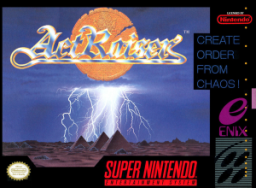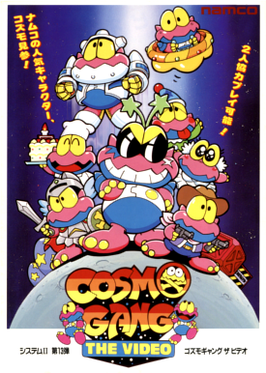
The Super Nintendo Entertainment System, commonly shortened to Super Nintendo, Super NES or SNES is a 16-bit home video game console developed by Nintendo that was released in 1990 in Japan and South Korea, 1991 in North America, 1992 in Europe and Oceania, and 1993 in South America. In Japan, it is called the Super Famicom (SFC). In South Korea, it is called the Super Comboy and was distributed by Hyundai Electronics. The system was released in Brazil on August 30, 1993, by Playtronic. Although each version is essentially the same, several forms of regional lockout prevent cartridges for one version from being used in other versions.

The NES Zapper, also known as the Video Shooting Series light gun in Japan, is an electronic light gun accessory for the Nintendo Entertainment System (NES) and the Japanese Famicom. It was released in Japan for the Famicom on February 18, 1984, and launched alongside the NES in North America in October 1985.

Pilotwings is an amateur flight simulator video game developed and published by Nintendo for the Super Nintendo Entertainment System. The game was originally released in Japan in December 1990, shortly after the launch of the Super Famicom in the country. It was also released as a launch title for the SNES in August 1991 in North America, with a European release following in 1992.

ActRaiser is a 1990 hybrid platformer, god game, and city-building game with light action RPG elements for the Super Nintendo Entertainment System developed by Quintet and published by Enix, combining traditional side-scrolling platforming with urban planning god game sections. A sequel, ActRaiser 2, was released for the Super NES in 1993. In 2007, ActRaiser became available on the Wii's Virtual Console download service in Europe, North America, and Japan. A version of the game was also released for European mobile phones in 2004. A high-definition remaster, ActRaiser Renaissance, was released for several platforms in 2021.

Rampart is a 1990 video game released by Atari Games and Midway Games that combines the shoot 'em up, strategy, and puzzle genres. It debuted as an arcade game with trackball controls, and was ported to home systems. It had a limited US release in October 1990, and a wide release in early 1991. It was distributed in Japan by Namco.

Super Street Fighter II: The New Challengers is a competitive fighting game produced by Capcom and originally released as an arcade game in 1993. It is the fourth game in the Street Fighter II sub-series of Street Fighter games, following Street Fighter II: Hyper Fighting. It refines and balances the existing character roster from the previous versions, and introduces four new characters. It is the first game on Capcom's CP System II hardware, with more sophisticated graphics and audio over the original CP System hardware used in previous versions of Street Fighter II.

Kirby Super Star, released as Kirby's Fun Pak in PAL regions, is an anthology platform video game developed by HAL Laboratory and published by Nintendo for the Super Nintendo Entertainment System in 1996. It is part of the Kirby series of video games by HAL Laboratory. The game was advertised as a compilation featuring eight games: seven short subsections with the same basic gameplay, and two minigames.

Axelay is a 1992 scrolling shooter video game developed and published by Konami for the Super Nintendo Entertainment System. Set in the fictional solar system Illis where an alien empire known as "Armada of Annihilation" invades its planets including the Earth-like Corliss (Mother), players take control of the titular D117B space fighter craft as a last resort to stop the alien invasion by recovering its lost weaponry. The gameplay mainly consist of both vertical-scrolling and horizonal-scrolling stages in the same vein as Konami's own Life Force, with players choosing three different weapon-types that increase in number as they progress through the game.

Super Tennis is a 1991 tennis video game for the Super NES. It was released at early points in the Super Nintendo's shelf lives and uses mode 7.

Earth Defense Force is a 1991 horizontal scrolling shooter video game developed and published by Jaleco. Originally an arcade game, the game was later released for the Super Nintendo Entertainment System as Super Earth Defense Force, dropping the two-player cooperative gaming mode while adding graphics and selectable weapons. The SNES version was released in Japan on October 25, 1991, and in North America in January 1992. The SNES version was eventually released on the Wii Virtual Console in Europe on October 29, 2010, in Japan on January 11, 2011, and in North America on July 14, 2011. It is included in Nintendo Switch SNES Online as of September 5, 2019.

Super Ghouls 'n Ghosts, known in Japan as Super Demon World Village, is a platform video game developed and published by Capcom for the Super Nintendo Entertainment System in 1991. As the third game in the Ghosts 'n Goblins series and the first not to be released for the arcade, it again depicts knight Arthur saving Princess Guinevere and the kingdom from Emperor Sardius, who has cast a spell that has revived the Ghoul Realm.

R-Type III: The Third Lightning is a 1993 side-scrolling shooter video game developed by Tamtex and first released in Japan by Irem in 1993 for the Super Famicom and in North America and Europe in 1994 for the SNES.

Cosmo Gang the Video is a 1992 fixed shooter arcade game developed and published by Namco. A home conversion for the Super Famicom was released the same year. Controlling the Hyper Beat starship, the player is tasked with ridding the galaxy of the Cosmo Gang, a race of aliens that cause mischief across Earth. Gameplay involves shooting enemies and avoiding projectiles. Power-up items can be collected to grant the player additional abilities. It ran on the Namco System 2 arcade board.

D-Force is a 1991 vertical scrolling shooter video game developed and published in Japan by Asmik for the Super Famicom and later localized and published in North America by Asmik Corporation of America for the Super NES. It involves an Apache helicopter set on defeating an evil Middle Eastern dictator. There are seven levels which feature six countries. Some of the levels involve switching altitudes in order to attack enemies from a different height, which uses Mode 7, one of the main features of the Super NES.

Alien vs Predator is a 1993 beat 'em up video game for Super Nintendo Entertainment System, developed by Jorudan and published by Information Global Service in Japan and by Activision internationally. An arcade game of the same title was released by Capcom eight months later, but the two games are different and their storylines are unrelated to each other.

Street Fighter II Turbo: Hyper Fighting is a competitive fighting game released by Capcom for arcades in 1992. It is the third arcade version of Street Fighter II, part of the Street Fighter franchise, following Street Fighter II: Champion Edition, and was initially released as an enhancement kit for that game. Released less than a year after the previous installment, Turbo introduced a faster playing speed and new special moves for certain characters, as well as further refinement to the character balance.

TwinBee is a vertically scrolling shooter released by Konami as an arcade video game in 1985 in Japan. Along with Sega's Fantasy Zone, released a year later, TwinBee is credited as an early archetype of the "cute 'em up" type in its genre. It was the first game to run on Konami's Bubble System hardware. TwinBee was ported to the Family Computer and MSX in 1986 and has been included in numerous compilations released in later years. The original arcade game was released outside Japan for the first time in the Nintendo DS compilation Konami Classics Series: Arcade Hits. A mobile phone version was released for i-mode Japan phones in 2003 with edited graphics.

BlaZeon is a horizontally scrolling shoot 'em up arcade game released by Atlus in 1992 and was ported to the Super Nintendo Entertainment System in the same year. The game's most distinguishable feature is that players come equipped with a device that allows them to freeze and control certain robots.

Goal! Two is a soccer (football) video game developed by Tose for the Nintendo Entertainment System (NES), and published by Jaleco in 1992. Goal! Two is Tose's first sequel to the NES title Goal!. On 04/24/92, Tose's first soccer title for the Super Famicom, Super Cup Soccer (スーパーカップサッカー) was published by Jaleco. It was later ported to the Famicom on 09/25/92 as Goal!!. Jaleco localized the Famicom game for the NES as Goal! Two for North American markets, and Goal! 2 for European markets later that year. Finally, the Super Famicom version was brought to the Super NES (SNES) as Goal! for North America and Super Goal! for Europe in December 1992, shortly after Goal Two! for the NES. The cover model is John Brady, an amateur soccer player from London who was living in Chicago.

Gradius III is a 1989 scrolling shooter video game developed and published by Konami, originally released for the arcades in Japan and other parts of Asia on December 11, 1989. It is the third game in the Gradius series. The game was ported to the Super Nintendo Entertainment System in Japan in 1990 and North America in 1991, and served as a launch title for the system in North America. The arcade version would never see the light of day in the West until it was included alongside Gradius IV in a two-in-one compilation for the PlayStation 2 and in the Gradius Collection for the PlayStation Portable.





















